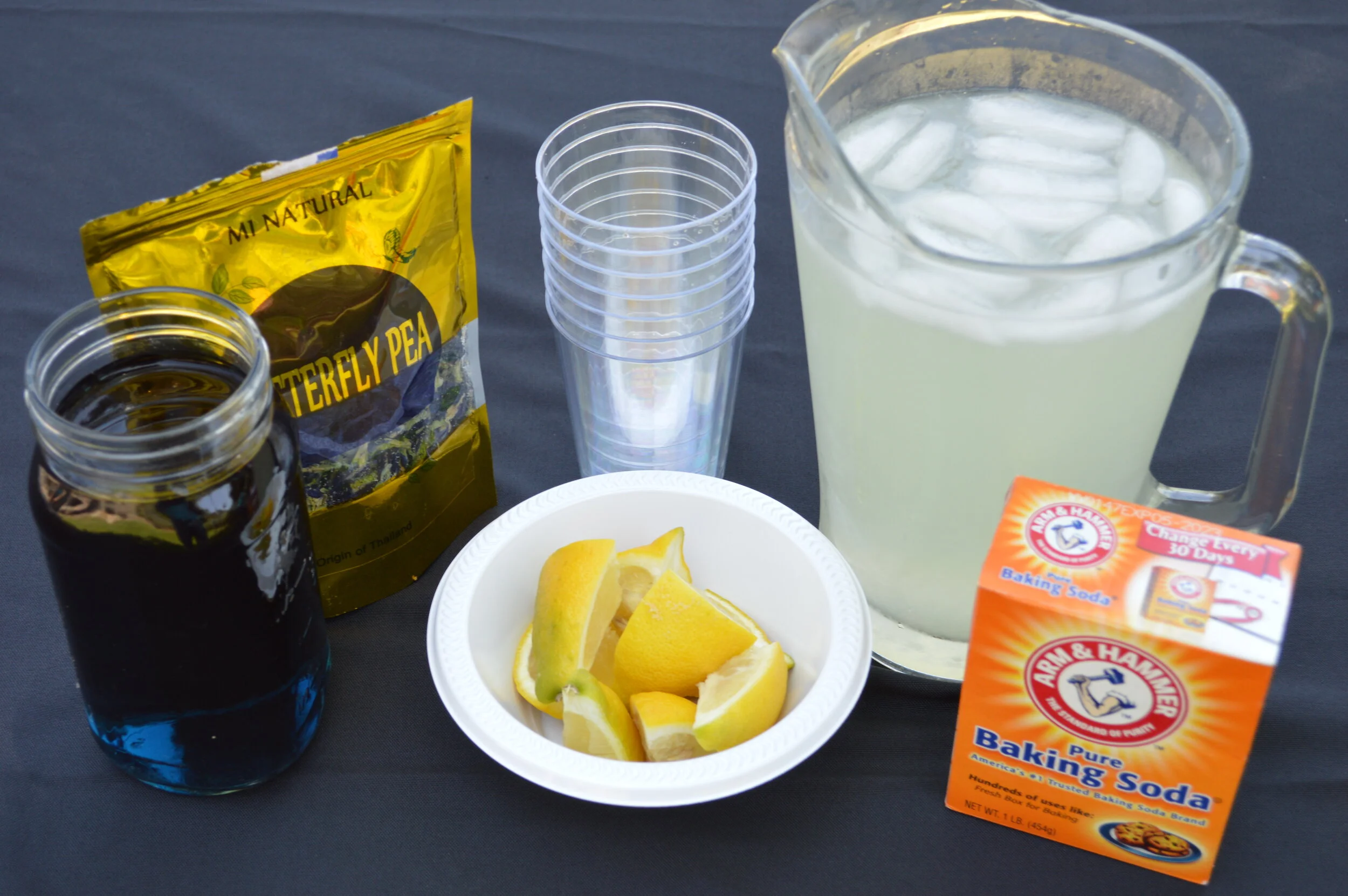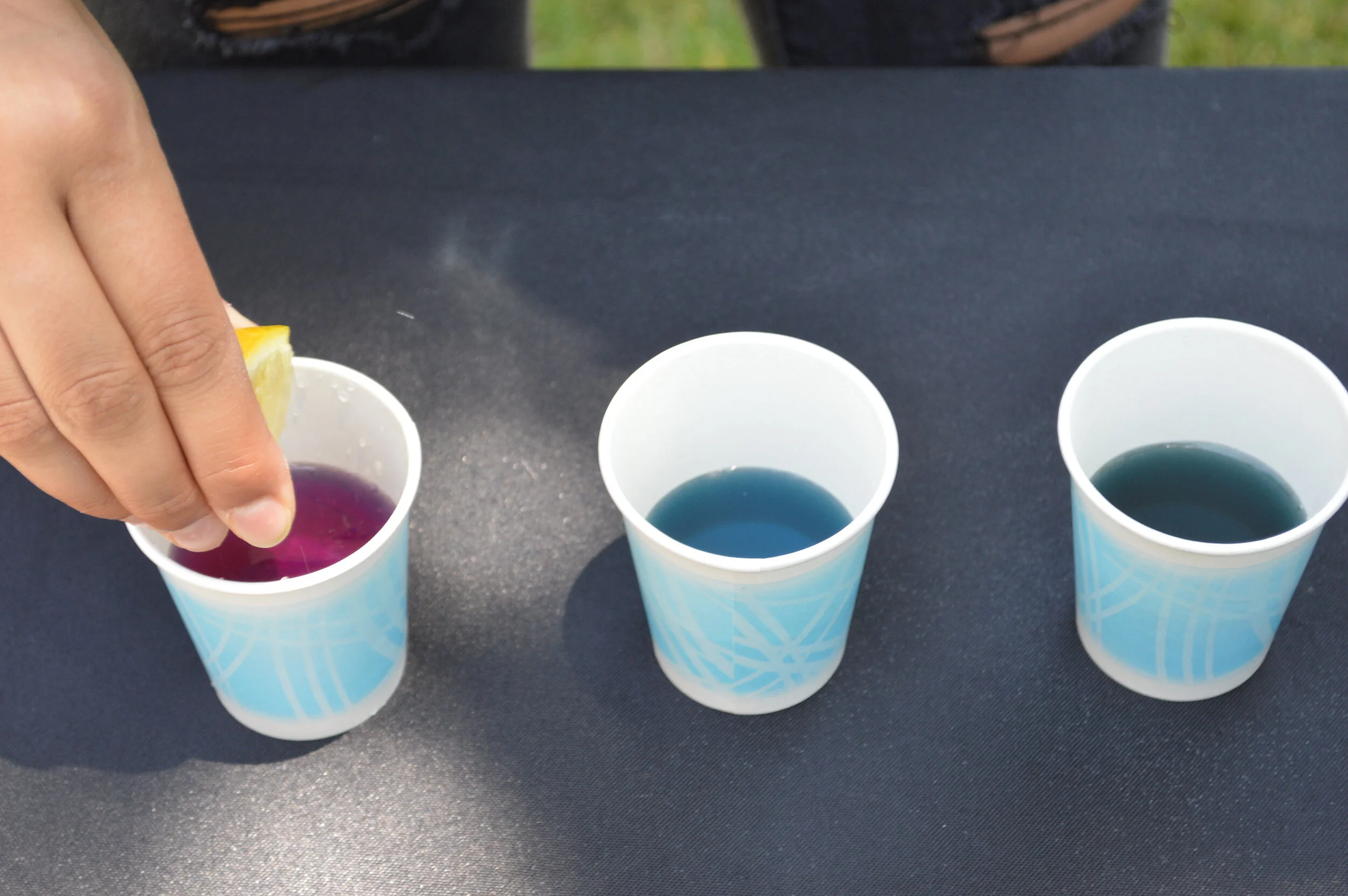Color-Changing Lemonade
Craving a glass of lemonade on a hot summer day? Grab some butterfly pea tea to make a beautiful and refreshing drink that doubles as a chemistry experiment. You can even talk about the life cycle of flowers while you enjoy.
Materials
1 butterfly pea flower tea bag or 1 tsp. loose flowers
1 cup of water
2 cups of lemonade
1 lemon (optional for extra experiment)
2 tbsp of baking soda (optional for extra experiment)
Procedure
Step 1
Make sure a grown-up helps you with this part! Heat water to near boiling, then add in the tea bag or loose flowers and let it sit for 3-4 minutes or until the tea is a deep blue color. Then, let it chill in the fridge.
Step 2
Fill two glasses with ice. Fill glasses with one cup of lemonade each.
Step 3
Sit down at a table with the lemonade glasses and a small cup filled with 1/4 cup of the butterfly pea flower tea and a straw for stirring.
Step 4
Pour some of the tea into to the lemonade, stir it up, and watch the color change!
Extra Experimenting:
Grab some leftover tea, a lemon, and some baking soda. Make sure a grown-up helps you cut the lemon in half!
Start by squeezing some lemon juice into the tea and see the color change to pink.
Then, add some baking soda and watch the color change to blue.
Keep adding lemon and baking soda to your liking to see the different colors you can make!
Science Explanation
Kingergarten - 2nd Grade . . .
- Bees and other pollinators have color vision to help them find the flowers that have nectar and pollen that they prefer. The blue-purple flowers of the butterfly pea plant attract bees and butterflies. (NGSS 2-LS2-1)
- The blue-purple color of the butterfly pea flowers (and the tea that it makes) has special properties. When the colored tea is mixed with an acid (like lemon juice), the tea turns pink. The more lemony your lemonade, the more pink the tea will turn (the more sour, the more acidic!).
- If you tried the extension activity, you’ll notice that adding baking soda made the tea turn a green-blue color. That’s because baking soda is the opposite of an acid. Baking soda is a base.
- You can even try adding different things to the tea to test if they are acids or bases. Try adding vinegar, ammonia, soap, toothpaste, clear soda, bleach. Based on the color change you see, are these acids or bases?
(NGSS 2-LS2-2) (NGSS 2-LS4-1) (NGSS 2-PS1-4)
3rd Grade - 5th Grade . . .
- Pollinators (bees and butterflies) are very important in the reproduction of plants. Flowering plants, like our butterfly pea flowers, use brightly colored flowers to attract pollinators.
- Once a flower is pollinated it can make more seeds. The seeds of a plant are spread through the wind, animals, water, or humans who intentionally spread them when gardening. (NGSS 3-LS1-1)
- So why did we observe a color change when we added the tea to lemonade? (NGSS 5-PS1-1) (NGSS 5-PS1-4)
- Matter is the “stuff” that makes up everything. All living, dead, and non-living things are made up of matter. Matter cannot always be seen, like in the air, but it is always there.
- Any type of matter can be divided into particles that are too small to see. These particles interact differently in many interesting ways with the other particles around them.
- The blue-purple color of the butterfly pea flowers is due to a small particle called anthocyanin pigment. When we added the flowers to hot water, the pigment went into the water, making tea. This pigment-filled tea has special properties.
- When the tea is mixed with an acid (like lemon juice), the tea turns pink. The more lemony your lemonade, the more pink the tea will turn (the more sour, the more acidic!). We mixed an acid and anthocyanin to get a new substance. This substance was pink! This is an example of a chemical reaction.
- If you tried the extension activity, you’ll notice that adding baking soda made the tea turn a green-blue color. That’s because baking soda is the opposite of an acid. Baking soda is a base.
- You can even try adding different things to the tea to test if they are acids or bases. Try adding vinegar, ammonia, soap, toothpaste, clear soda, bleach. Based on the color change you see, are these acids or bases?
Written by Alina Silva and Julia Wang From our friends at Left Brain Craft Brain





